The Fat Duck, surely one of the galaxy’s most famous dining destinations, tucked away in the London exurb of Bray, is in fact two of the world’s most creative restaurants. The problem is that they do not always fit together harmoniously. One is to be applauded for its culinary brilliance; the other for its cleverness. One is Per Se, the other April Fools. One produces astonishing food; the other forces astonished diners to question what food really is. Is food anything that a chef dares to place on the plate? One is modern cuisine, the other hyper-modern games and molecular buzz.
The Fat Duck appears a rural inn from its pubby name to its exposed beams and white walls. The only signal that this is other than small-town Britain is a few abstractions on the walls in yellow and chartreuse. As is so common, service in the temple of modern cuisine is attentive and gracious; service at the house of games is demanding and controlling. At the first the diner is king; at the later, he is a pawn. And throughout the meal The Fat Duck sells itself from the small placard on the table that encourages the purchase of Chef Heston Blumenthal’s cookbooks to the several odd objects emblazoned with the name and visual markings of the establishment. Blumenthal has not moved as far as some in turning himself into a brand, not yet opening branches in Dubai and Las Vegas, but perhaps the time is not so far off. The current chef, overseeing the cuisine at The Fat Duck is Ashley Palmer-Watts, who deserves much credit for the day.
One’s tasting menu begins with play. A server appears with a smoking kettle of nitrogenated ice in which she places a white sphere: a immediate freeze by one of MacBeth’s witches. This is the opening palate cleanser of Nitro-Green Tea and Lime Mousse. I am informed that it is to be eaten whole; and when I chose to consider the dish in two bites, I am chided for my effrontery. So much for clichés about the client’s authority. The ball itself is tartly citrus with a smidge of vodka. As advertised, it is a clarifying moment.

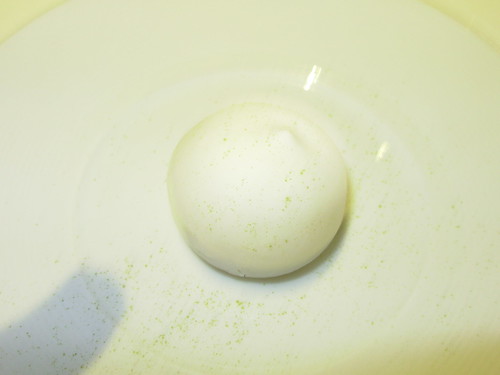
The second amuse brings a plate with two small squares of jelly: one orange and one beet red. The server orders me to eat the orange first. I follow instructions despite a growing desire to rebel by combining half of each. What’s up? The orange gel tastes of beet; the red square tastes of orange, just like those experiments in home economics in which green food coloring is added to cherry ice and red to mint. As it always has been, this is a cute idea for a class in food science to demonstrate the power of expectations, but the idea triumphs over the senses.

This experiment was followed by a lovely, little thing: a fresh oyster with passion fruit jelly and a sprig of lavender. Although the lavender didn’t add much to this particular dish, the combination of fruit and bay was delightful. This is the first of the dishes that demonstrates that the kitchen can cook – although if one is discussing raw oysters, “cook” is not precisely apt.

The next small treat was “soup,” although soup that one needed a magnifying glass to spot, Red Cabbage Gazpacho, served with a micro-scoop of Pommery Grain Mustard Ice Cream. The soup was luscious, luminous, and light, all that one expects of a chilled soup. I only wish I had a bowl and not a tumbler. The flavor of cabbage was distinctive, but not overwhelming, and the royal purple contrasted smoothly with the tan custard.

The following intersecting courses were described as an “Homage to Alain Chapel.” How the late chef might feel about such an honor will never be known. I was informed that I must first lay a small film infused with oak flavor on my tongue, waking me for the touches to come, adding a whispered note of terror, if not terroir. However, this Sleeping Beauty trick was neither deadly nor delightful. Set on my table was a bonny package of oak moss that was flirtatious enough, but even when a liquid infusion caused it to smoke vigorously, it was more a proposition than than a passion. Here was molecular cuisine at its most jejune. A jest of the dark woods at table. This complaint does not neglect the insistent flavors of the dishes served as sides. The oak moss and truffle toast was carefully plotted and an evocative of the fungal bed. Compact, tightly bound, and explosive with aroma. Better still was one of the finest preparations of the day, an inspiring parfait with layers of quail jelly, langoustine cream, and foie gras mousse. Each satin sheet was urgently composed and together was an amorous moment. This parfait was as much a climax as an appetizer could be.



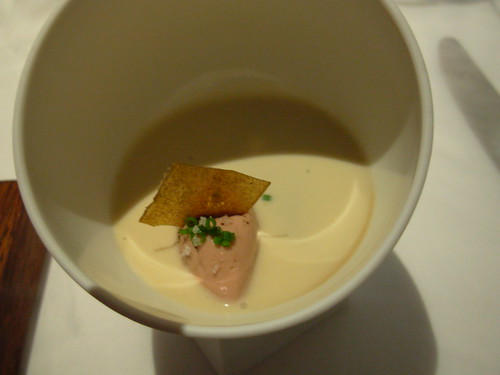

And now the meal became serious and profound – for awhile. The first of the larger course was Chef Blumenthal’s signature Snail Porridge, served with Joselito ham and shaved fennel, described by the organizationally immodest server as “our famous snail porridge.” The snails might speak for themselves, but whether famous, infamous, or anonymous, this was a breakfast of champions – fusing two of the meal’s motifs: breakfast in the woods. The green porridge, the translucent fennel, the rosy ham, and the dark snails made beautiful harmony. Flavors that seemed far distant became as one. This porridge wakens the limp and restless.

Following the porridge was is tribute to Foie Gras, what each fat duck will be without: Roast Foie Gras with Almond Fluid Gel, Cherry Sauce and Chamomile Jelly. Here was foie gras marzipan with bursting cherry notes. The fruit was cherry cubed, so intense was its flavor. Not only was the dish symphonic in taste, it was fluid and expressionist in presentation. A magnificent treat.

And then “The Sound of the Sea.” Here was molecular cuisine as wack. The server brought out a large conch shell with earphones which I was ordered to wear. Inside the shell – why? – was a small iPod – why? Putting on the earphones, one heard the sound of waves – why? And I sat for perhaps five minutes experiencing a cross between vexation and bondage, feeling little of the wispy shore breeze in this snug little cottage by inland Bray. Let me be blunt: it was dumb. The chef’s desire for discipline outweighed any hint of pampering.
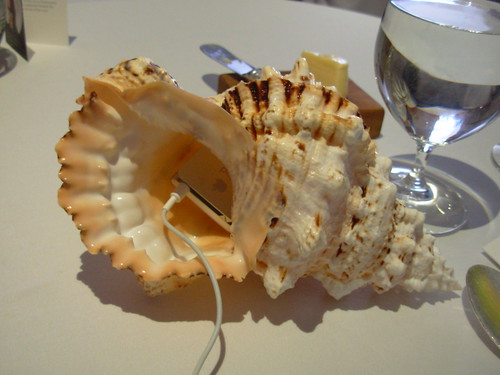
As I began to lose hope, fearing that I would be dunce for the afternoon, perhaps feeling a touch nauseated, the food arrived. If the dish was not among the finest creations of the tasting menu, it was far more evocative than the attempt at Radio Free Bulli. The chef sculpted a shore scene with tapioca sand, sea foam, fried baby eels, razor clams, cockles, and a quartet of Japanese seaweed species. It was a curiosity, too clever by half for greatness, but a thoughtful attempt to build on an unusual mix of textures.

Finally arrived the crux of the meal: an indelible dishes, a creation of gustatory renown: Salmon Poached with Liquorice, Asparagus, Pink Grapefruit, Vanilla Mayonnaise, and Olive Oil. The salmon, moist and succulent, was enveloped by a dark, mysterious, potent, slightly bitter film. Served on a plate by its lonesome it would have been splendid, but the companion tastes, each paired in a bite were gravely symphonic. Modern cuisine does not get better than this, and inspires me to forgive – sort of – the fooling before and after. I was tempted to ask for Hester’s technique, but then realized that my evening fumblings might tarnish my memories of what Chef Blumenthal unfolded.

The meat course was perhaps the most “traditional” of the afternoon: best end of lamb with onion and thyme fluid gel with a potato fondant. The best end of lamb included tongue, neck, and sweetbreads, leaving this lamb silenced – along with part of the lamb’s rack. This was a fine, sturdy dish – and a rich and thoughtful one, unafraid of the dense flavor of the thyme gel. If it was an anti-climax – and in some measure it was – this evaluation was a function of what came before.

The liquid palate cleanser was labeled “Hot and Iced Tea.” Two distinctly textured liquids – one rather warm and gummy, the other cool and fresh within the same cup. The trick was that the cup appeared to contain a single liquid, while actually constituting a science experiment. Like teaching a dog to waltz, it was more impressive in theory than in practice.
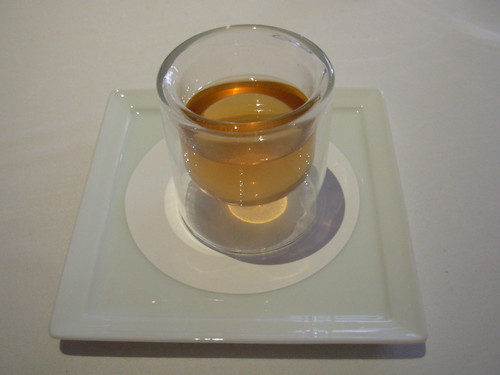
This was followed by a small dish, “Mrs. Marshall’s Margaret Cornet,” named after a frozen dessert pioneer: apple ice cream with orange and ginger granita. This small cone with its smooth flavors and elaborated decoration was a nostalgic reference to the days when visiting the ice cream parlor was an occasion, not merely an errand.
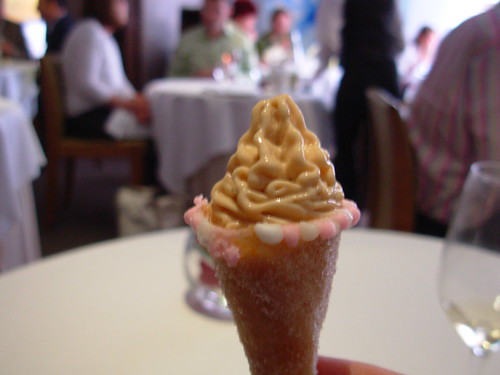
I could have skipped the “Pine Sherbet Fountain” – sugar powder with a pine aroma. First, oak, now pine, soon poison ivy. I scooped the power with a vanilla bean that added some taste, but didn’t persuade me that this was other than a tease of the late afternoon heat.

The main dessert – Mango and Douglas Fir Puree with a Bavarois (Bavarian cream) of lychee and mango with an intense blackcurrant sorbet – was precisely presented, a stunning picture. As a serious presentation, the dessert was welcome, although I felt that the flavors did not merge as well as some earlier courses. It was a plate in which the sum of the parts was more impressive than the combined taste.
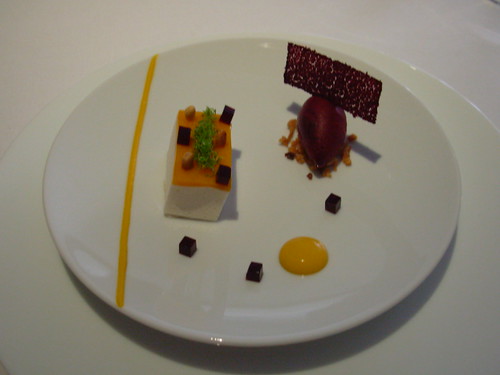
After this effort of the pastry kitchen, we returned to ideas, forgetting gustatory triumphs. First, I was served a Carrot and Orange Tuile – a high-end lollypop - with a beetroot jelly square, a reference to the earlier surprise but with the color matching the taste.

As the meal ended – perhaps most appropriate for those evening repasts that concluded in the wee hours – I received a box of parsnip cereal – Fat Duck brand - served with parsnip milk. Perhaps one can’t squeeze blood from a turnip, but apparently Chef Blumenthal can tease breast milk from a parsnip. Cereality indeed.


I concluded with the second course of a molecular morning repast, another Blumenthal signature: Nitro-Scrambled Egg and Bacon Ice Cream with Pain Perdu and Tea Jelly. Like the opening nitro-Green Team and Lime Mousse, this was a tableside presentation. The kitchen wizards infused an egg in its shelf with bits of bacon, When cracked into a pan, mixed with liquid nitrogen – kazaam! – ice cream resulted. Cuteness trebled, cooled and warmed through magic. Better living through chemistry, although I prefer better living though stovework. It was an impressive end, although not the most impressive in flavor. The conjurer’s trick seemed designed to wheedle a standing ovation. The breakfast was somewhat in-between brilliant and curious, in-between funny delightful and funny odd.

With the weak American dollar a tasting menu at The Fat Duck is an investment in reverie, and has some rough patches. Yet, it is not an experience that I would have missed. Perhaps The Fat Duck is two restaurants in one – one molecular, one inspired – but both reveal how magical a meal can be. This is a cuisine agape. I left with my heart aflutter and my mouth agape.
The Fat Duck
High Street
Bray Berkshire
+44 01628 580333
http://www.fatduck.co.uk
[url=http:://www.vealcheeks.blogspot.com]Vealcheeks[/url]

2 comments:
Great pictures. Thanks for sharing.
Very interesting review; as clever as the meal itself I dare say. Thanks
I recently had my first experience of molecular gastronomy at Wylie Dufresne's WD~50 in New York City. http://goodfood65.blogspot.com/2008/06/wd50-lower-east-side-manhattan-new-york.html
Post a Comment